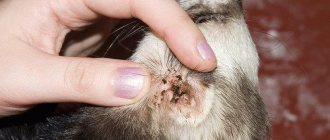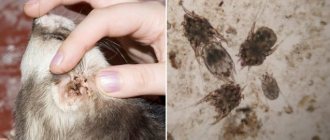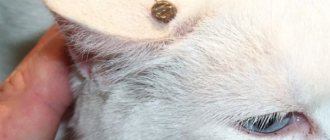Otodectes cynotis is a parasitic disease. The causative agent is an ear mite that is difficult to see with the naked eye. Ear scabies are a fairly common disease among domestic and wild cats. This parasite lives and parasitizes on the surface of the skin, especially in the area of the ears, penetrates the ear canal, actively multiplies and can even reach the eardrum. In advanced cases, the pathogen reaches the brain and invades it, causing severe inflammation and destruction of the brain. The mite feeds on dead and living epithelial cells of the skin of the auricle and external auditory canal; the parasite develops quickly. The life cycle of the parasite usually takes 3-4 weeks. In the external environment or on the body of an animal, a tick can live up to 25 days.
What is otodectosis in cats?
A disease of the outer ear caused by the microscopic parasite Otodectes cynotis, known by such names as otodectosis in cats, parasitic otitis media, ear scabies, and ear mites.
At first, one ear is most often affected, then the disease spreads to the second. When an animal sleeps, it curls up into a ball. Therefore, when a cat has otodectosis, the parasite is able to settle in other areas: the neck, tail, and pelvic area. Outwardly, it may look like dermatitis, allergies, flea bites.
Under good living conditions, proper nutrition, and regular ear cleaning, otodectosis sometimes occurs asymptomatically and goes unnoticed by the owner.
Many cats are carriers of mites without any external manifestations.
However, with deterioration of care, unbalanced feeding, and weakened immunity, ear mites can enter the active stage. Then the disease acutely manifests characteristic symptoms, and treatment directly depends on the condition of the “patient”.
In kittens and young animals the disease is severe. A kitten becomes infected especially quickly from other animals and from its mother.
How contagious
Otodectosis is a contagious disease, as already mentioned. In most cases, even 5 minutes of interaction with an infected animal is enough for your pet to become infected from someone. But a person need not be afraid of ear mites - our body temperature is not suitable for the parasite to reproduce.
The only danger is pseudoscabies (rash) caused by bites from frequent contact. Drops will not help here, so you should simply use gloves when treating infected areas of your cat. We must not forget that a person can suffer otodectosis (through clothes, shoes).
Briefly about the pathogen
Otodectes cynotis, the causative agent of the disease, is so small that it is difficult to see with the naked eye. Its body dimensions are approximately 0.2-0.5 mm. However, if you examine with a magnifying glass what an ear mite looks like, you can see slowly moving pale yellow, white dots. The parasite feeds on skin scales from the ear canal of animals. Lives on the surface and does not dig.
The life of a tick lasts 3 weeks:
- Females lay eggs and attach them to the skin with a viscous substance and cement them. Each female lays 5 eggs per day.
- After 4 days the larvae appear. Within 3-10 days they begin to actively feed. Then comes the rest phase (from 10 to 30 hours).
- The cycle changes and the larvae move into different stages of development (protonymph and deutonymph).
- While in the deutonymph stage, the larvae attach themselves to the males. And if the deutonymph is a future female, then when she becomes an adult, she already turns out to be a carrier of eggs.
An adult lives on average 2 months. Life outside the animal lasts approximately 12 days.
Causes
Ear mites do not appear out of nowhere. When it develops, there is necessarily a carrier and reasons for the activation of the disease. The risk group includes kittens under the age of one year and weakened animals. The former become infected from the mother, and in the latter the pathogen “wakes up” after a malfunction of the immune system. There are three main causes of ear mites:
- Failure to comply with hygiene rules. The presence of people in a living space in street clothes, shoes, irregular washing of the rug at the doorstep. Small pests are found in tiny particles of sand and soil.
- Communication with sick animals. Upon contact with a sick cat, the pathogen travels to the pet directly or through the hands of the owner. Otodectosis does not parasitize humans, but they are its carriers.
- Street walks. Arthropods live in basements and attics, in grass and garbage containers.
The disease progresses individually in each specific case. Its intensity depends on the cat’s immunity.
Often the pest lives unnoticed in the pet’s body for months. At the first serious failure, stress or injury, the insect wakes up and begins to actively “suck” its host.
Otodectosis in cats: symptoms
To feed, the parasite injures the animal’s skin, from which a liquid is released that serves as food for it. Such microtraumas, as well as secretions and excrement released during life, irritate the skin and cause severe, unbearable itching. To alleviate the condition, the animal constantly shakes its head, scratches its ears with its paw, and rubs them against objects.
Due to mechanical damage to the skin on the back of the head and ears, scratches and abrasions are found, and patches of bald patches may appear. If the eardrum is damaged, the pet tilts its head to the side.
If left untreated, the condition worsens, and inflammation gradually develops - otitis media. Therefore, otodectosis is also called parasitic otitis media.
Over time, the inner surface of the ears turns red, the skin in this area thickens and gathers into folds. If the process is not stopped, the inflammation spreads to the eardrum, the inner ear and further penetrates the brain. In this condition, the pet’s body temperature rises, lethargy, convulsions or seizures appear.
The animal's behavior changes:
- sudden movements appear, running to nowhere;
- meowing when scratching ears;
- The cat presses his ears and does not allow his head to be stroked or his ears to be touched.
To understand what is happening to the cat, the owner needs to examine the ears. It will not be possible to examine the parasites. But the signs of ear mites in cats are immediately clear - an atypical color of plaque and severe itching.
If normally a cat's earwax is light with shades of yellow or brown, then with otodectosis the contents of the ear are dark brown and even black, resembling coffee grounds (as in the photo below).
Sulfur in otodectosis comes in different consistencies: dry, wet, loose, hard, pasty. If there is an inflammatory process, an unpleasant odor comes from the ear.
Prevention
In order to prevent the cat from falling into the ear mite trap again, you should monitor its health and, for the purpose of prevention, fulfill some mandatory conditions.
After any water procedures, you need to not only wipe the cat’s fur, but also be sure to dry its ears from the inside . This will prevent the formation of a damp environment and make it possible to keep them clean.
Your cat's ears need to be cleaned daily. It is contraindicated to do this with cotton swabs, so as not to drive the sulfur mass even deeper. But cleansing with lotion should become an essential part of caring for your pet. During this manipulation, you need to monitor for the presence of abnormal sulfur secretions.
Mites in the ear
Avoid contact with wild or street animals. For a domestic cat, such exposure will become the root cause of infection with various types of ticks and infectious diseases.
Organize wet cleaning of the house using antiseptic agents twice a week. With its help, it will be possible to exterminate those parasites that entered the house on the soles of shoes or outer clothing.
Video on the topic
Cleaning your cat's ears
You should acquire a useful habit: make an appointment at the veterinary clinic once a month. During a structural examination, the doctor will pay attention to all the details in the cat's health, which will prevent any diseases and maintain his health.
If, however, the pet could not be saved, then if the first symptoms of tick infestation are present, you should immediately contact a veterinarian. If for some reason this cannot be done, then you can use the service of calling a veterinarian to your home.
Have you encountered ear mites on your cat? Leave questions for the veterinarian in the comments. All articles..
Diagnosis of otodectosis
In a veterinary clinic, the diagnosis is made based on examination and examination of the contents of the ear under a microscope.
Basic methods:
- Using a special instrument, the doctor sees moving white dots.
- Studying sulfur under a microscope allows you to examine adults, larvae and eggs.
- The "positive ear" method. The doctor wipes the ear canal, and the cat reacts by trying to scratch with its hind paw.
If inflammation (otitis media) has developed, diagnosis becomes difficult. The fact is that with otitis media, an acidic environment is created in the ear, in which parasites die. Therefore, microscopy may not show results.
Also, before treating for otodectosis, the doctor must exclude other diseases that lead to inflammation of the outer ear: allergies, flea dermatitis and other types of parasites.
How to treat ear mites in cats
Before starting treatment for otodectosis in cats, many factors are taken into account:
- Conditions of keeping (does the cat go outside).
- The severity of the condition.
- Presence of other animals at home.
If there are other pets in the house, then general treatment is carried out. Treatment of the premises and objects is not required, since the parasite does not survive well in the environment. There is also no need to change your diet and lifestyle.
It is more effective to treat otodectosis in a cat that does not go outside and is kept entirely indoors using systemic medications. This is one way to get rid of ticks forever. If the cat is walking and in contact with other animals, parasites are removed with acaricidal preparations that are applied topically.
There is no quick cure for ear scabies in cats. On average, treatment takes 1-1.5 months.
It is important to keep your ears clean throughout your treatment. Otherwise, the cat’s ear mite takes refuge in wax and secretions, and acaricidal agents do not penetrate to the place of refuge.
Folk remedies
It is possible to remove ear mites at home using folk remedies only in the first stages of the disease. In their neglected form they do not produce results.
A well-known method of treatment with folk remedies is the use of sea buckthorn oil. They also use olive, almond, but not tea tree. Some people infuse garlic oil to kill bacteria. Oil may reduce irritation, but it will not get rid of the pathogen.
When ear mites are diagnosed in cats, treatment at home is not recommended. Traditional methods are safe, but ineffective.
Ways to combat the disease
Treatment options depend on many factors, such as how advanced the disease is and how much the ear canal is affected. After diagnosis, the specialist will prescribe a drug to remove ear mites in cats. Typically therapy consists of several stages:
- clean your ears regularly;
- use medicinal drugs;
- increase the animal's immunity.
Otodectosis should be treated with drops and sprays, and you will have to find an approach to the cat or dog - the procedure is not pleasant. It is important to follow some rules when using remedies against otitis and scabies to reduce the likelihood of relapse.
Cat health begins with hygiene and good immunity.
Treatment rules
Proper care of the feline is the main principle of treatment. It is necessary to protect other pets, otherwise ear parasites will spread to them. What you need to remember before starting therapy at home:
- Joint treatment. If there are other animals living in your house (otitis occurs not only in cats and dogs), it is advisable to treat their ears for 7-10 days. If there are no signs of the disease, traditional medicine will help - they are completely safe even for pregnant and lactating cats.
- Cleaning. It is recommended to thoroughly clean the house, as the larvae could remain wherever the pet walked. Be sure to wash the bed in hot water or use antibacterial agents for treatment. Unfortunately, larvae can remain in fabrics even after washing - it is better to repeat the procedure after a few days. Take the time to wash the curtains, wash your outdoor shoes, and thoroughly vacuum the carpet and furniture.
- Keep an eye on four-legged animals. As already mentioned, ear mites also affect other areas of the body, such as the paws or tail of an animal. When applying medicinal products to the fur, make sure that your pet does not lick them off.
And you always need to be proactive - a strong immune system allows you to avoid many diseases. To effectively boost immunity in cats or dogs, you should choose products with vitamins in consultation with your doctor. Attention is also paid to diet.
SUPERPET species-specific nutrition strengthens the immune system of cats, and otodecosis appears much less frequently in animals on a proper diet. According to the majority of clients whose cats were sick, after switching to SUPERPET, the health of their pets improved. Order the Starter Kit and get your first consultation with a veterinarian for free.
Drug therapy
There are many anti-otodectosis medications for pets, but only a specialist knows which one will help your pet. Before use, be sure to consult with him - all medications for otodectosis have contraindications.
What should you pay attention to when choosing a remedy for this unpleasant disease? First of all, safety, since possible side effects and risks should not exceed the therapeutic effect. Efficiency and convenience are also important, because your four-legged friend does not always like the treatment process. For comparison, here are the most accessible means:
- Decta. Drops with an antibacterial effect against ear mites. It is recommended to drip 4 drops into each ear canal with an interval of 5 days. Typically, a course for pets consists of 3-4 procedures. Contraindications include pregnancy and kittens up to one month old.
- Amidel. A gel that is applied to well-cleaned ears. The drug is used up to five times a week. Amidel shows excellent results in the treatment of many infectious diseases, however, it is prohibited to use it for pregnant cats, nursing cats and kittens.
- Amitrazine. Drops are instilled into the animal's ear canal every 3 days. 4-5 applications of 2-4 drops each are enough to cure the disease. Like many medications, it is contraindicated in pregnant females.
- Otoferonol Gold. Once a week, 2-3 drops are instilled into the affected ears - this procedure is repeated twice. The advantage is that the drug not only relieves the disease, but also heals irritated skin in the auditory organ in cats and dogs. These drops have contraindications: age and pregnancy.
- Aversectin ointment. Apply a thin layer of the substance to the inner surface of the animal's ear. Apply once every 7 days for three weeks. Effectively fights the parasite, as it affects the muscle cells of the tick.
Topical drops are not always good. They often only work during treatment: once the drug is stopped, the ear mites may return. In addition, some of them cause a strong burning sensation when they come into contact with the irritated skin inside the ears.
Experts often recommend taking a closer look at systemic medications, namely drops on the withers against otodectosis in cats and dogs. It is also necessary to mention Gamavit and Tetravit - these are immunostimulants that are administered intravenously. It is unacceptable to use these drugs on your own, since the drug must be prescribed and administered by a veterinarian.
All medications are prescribed by a veterinarian, and treatment must be carried out under his supervision.
ethnoscience
To treat otodectosis at the earliest stage, when there is no visible damage to the ear canal, you can use folk remedies for scabies. It is also advisable to resort to them when ticks appear in pregnant and lactating cats, as well as kittens.
ATTENTION! We strongly recommend that you consult a veterinarian before using traditional methods to combat ear mites in cats.
The first thing you need to do at home is to clean your ears. To do this, you should use a cotton pad, not swabs, as they can easily damage the hearing aid. Soak the swab in warm water, squeeze lightly and gently remove wax and discharge from the ears of cats. Repeat the procedure as necessary.
Then you can start processing your pet’s shells using folk recipes. One of them is a strong infusion of green tea leaves. You need to use loose leaf tea, not bagged tea (it should be without any additives). Brew the leaves, cool so that the liquid is warm, and drop 2-3 drops into the animal’s ears. You need to be careful - you may be allergic to tea.
Garlic ointment and infusion are effective means of combating ear scabies in cats. Pass ½ clove through a press and mix with 2 tbsp. l. vegetable oil and leave for 24 hours, then strain through cheesecloth. Lubricate the cleaned inner surface with the resulting substance once a day. The duration of treatment is approximately a month. Important: garlic should not be used if there is irritation or wounds on your pet’s skin.
Almond oil also shows good results. After cleaning the animal's ears, you need to drop 2-3 drops into the ear canal to treat scabies. Repeat daily for two weeks until ear parasites disappear. Oil can also be used to remove dirt, but frequent use can cause dryness. 3% hydrogen peroxide works well for cleansing.
Let us repeat that the presence of obvious symptoms of otodectosis in cats (severe itching, odor from the ears, dark plaque) is a good reason to put homemade drops away and visit a specialist. The longer you delay this moment, the more time it will take to treat your furry friend.
Possible complications
With timely treatment, otodectosis does not cause complications.
With a prolonged illness, dangerous consequences are possible:
- Otitis is an inflammatory process accompanied by the release of pus inside the ear. Therefore, if otitis media accompanies otodectosis, then the goal of treatment is not only to destroy the parasite, but to free the ears from germs. For ear mites, cats are prescribed rinsing with antiseptics (dioxidine, chlorhexidine) and a course of antibiotics.
- Hematoma of the auricle. With otodectosis, the pet itches and can damage blood or lymphatic vessels with its claws. If a blood vessel is injured, a hematoma forms. When a lymphatic vessel ruptures, lymph accumulates under the skin. For hematomas in cats, there is no treatment at home, only surgery. The mass is opened and antibiotics are prescribed.











